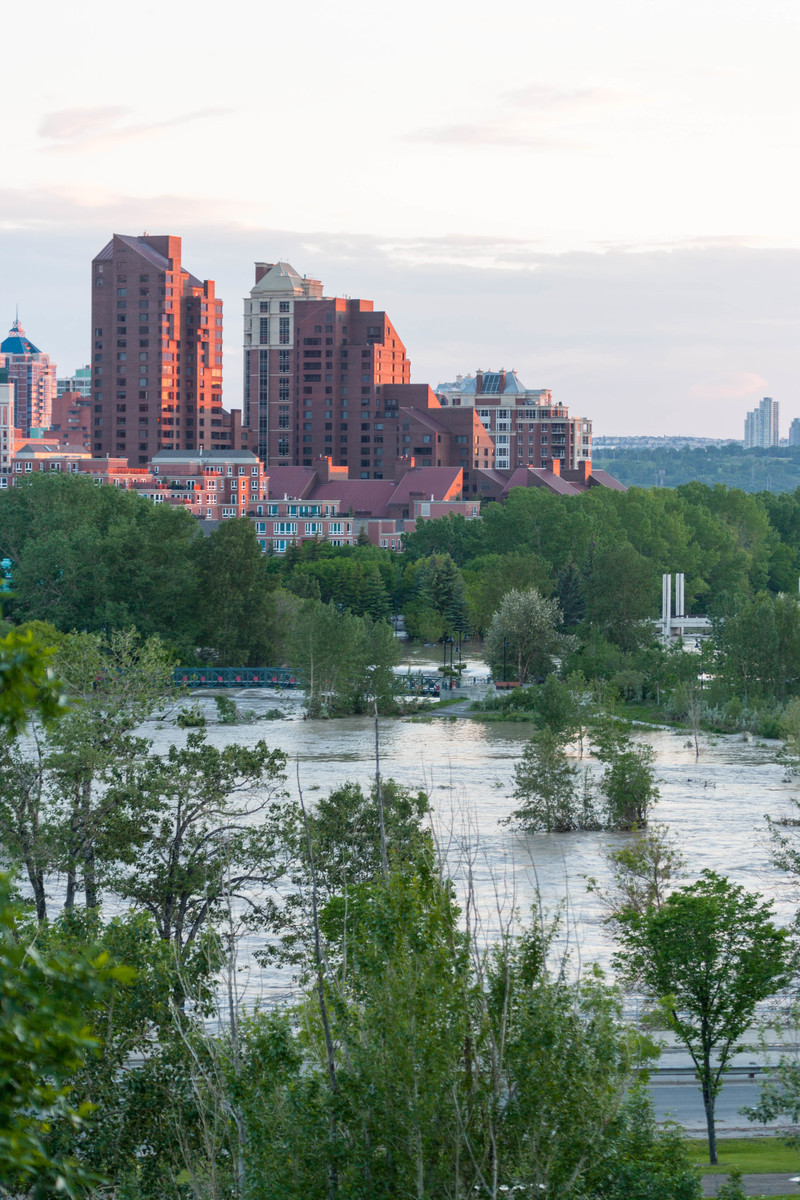Climate hazards: Heavy rain and flooding
This page provides non-emergency solutions to tackle climate change. If you are in an emergency, visit be prepared for flooding or what to do during heavy rain.
In Calgary there are different types and causes of flooding.
- River flooding can occur when there is heavy rainfall in the mountains and foothills combined with a melting snowpack in the spring.
- Local stormwater flooding can occur during a heavy rainfall in Calgary, which can cause local drainage issues. Rain water may flow through streets, or pool in low spots until it can drain into the stormwater system.
With climate change, the amount and intensity of extreme precipitation events is increasing. In Calgary, we can expect rainstorms less than a day in length to have about 28% more volume by the 2050’s. This will make stormwater flooding more common.
For your home and property, the most common concern is basement flooding. Basement flooding can be caused by overland water entering your home through:
- Openings
- Sewer backup from the sanitary or storm systems
- Seepage into the basement due to changes in the groundwater table
- Poor lot drainage
Flooding in your home can cause mold to grow, leading to long-term health impacts if not appropriately addressed. In worst-case scenarios, damage may occur to the structure and foundation of your home, making it unlivable.
-
Download the handout to protect your home from flood and heavy rain
Flooding vulnerability
Consider the following questions. The more questions you answer as YES, the more vulnerable your home and property may be to damage from flooding.
| Question | Yes/No |
|---|---|
|
Check The City’s Flood Map. Do you live in an area at risk of river flooding or in close proximity to a natural water body? |
|
| Do you see water ponding in your yard on a regular basis? | |
| Has your basement ever flooded? | |
| Do you have a finished basement? | |
| Are there any unsealed cracks in your foundation or basement floor? | |
| Do you have basement windows close to the ground, or below the ground (window wells)? | |
| Does the grading of your lot, or your driveway, slope towards your house? | |
| Do you have downspouts that direct water towards your home, or that drain close to your foundation walls? | |
| If you have a sump pump in your home, does your sump pump operate frequently (e.g., when the river is high in spring, or when it rains)? |
How to reduce flood impacts
These climate ready measures may help reduce damage if your home is vulnerable to heavy precipitation and flooding.
In the home
Do
- If possible, avoid building living spaces in the basement.
- Repair cracks in the basement foundation.
- Install a back-flow prevention device on your sewer pipe. This helps protect your home from sewage backups associated with extreme rainfall and stormwater flooding. These can also be installed in basement showers, toilets, and sinks.
- Install a sump pump with a back-up power source.
- Install water alarms in the basement to alert you if water is backing up.

Outdoors
Do
- Improve your lot grading so that it slopes away from the house foundation. This can be done when building a new home or landscaping your yard.
- Install eavestroughs and downspouts if your home does not have them. Ensure downspout extensions direct water at least 1.5 metres away from your house, and not toward your neighbours property.
- Clean your roof, eavestroughs, downspouts and drainage gutters clear of debris by removing needles, leaves, etc.
- Consider choosing permeable materials when building new or re-doing your driveway or sidewalks. Permeable concrete, asphalt and paving stones allow water to readily move through and into the soil. They are better at absorbing water and help protect against extreme heat.
- Report plugged storm drains by calling 311.
- Park your vehicles on higher ground or in your driveway if you have low spots on the street where water collects.

To learn more about protecting your home from flood impacts, visit calgary.ca/floodinfo. Additionally, refer to the Institute for Catastrophic Loss Reduction’s Homeowner Guide: Protect Your Home From Basement Flooding.
Use the Intact Centre on Climate Adaptation’s Home Flood Protection Check-Up Tool to receive a confidential report that identifies actions that can reduce your vulnerability to flooding and help you qualify for insurance discounts.
The climate ready measures identified here can minimize the damage but will not fully protect your home from river flooding. Residential structures are unable to withstand floodwater damages from river flooding unless specifically designed to do so.
Check the flood map to determine if your home is located in the floodway, flood fringe or overland flow zone of the Bow River, Elbow River, Nose Creek or West Nose Creek. If it is, specific land use regulations apply.
For more information on official and recommended flood elevations, and the development and building regulations that apply in each designated flood zone, please refer to Calgary’s Land Use Bylaw, Part 3 Division 3, or contact The Planning Services Centre at 403-268-5311.

Translated handouts
Disclaimer: The content of the Climate Ready Home Guide is for informational purposes only and cannot be construed as technical advice with respect to any particular building(s) or construction project(s). The Climate Ready Home Guide does not recommend or endorse specific products or companies. All products and measures should be installed by a professional contractor, according to manufacturer specifications and following all City Bylaws and codes.

